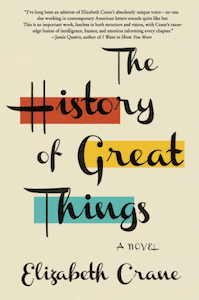
Elizabeth Crane’s new novel The History of Great Things is groundbreaking in its imaginative perspective on an age-old conflict, the mother/daughter relationship. The book is co-narrated by Betsy Crane (a version of Elizabeth) and her mother Lois. The author constructs both real and imagined scenarios as Betsy regards them and as she imagines her mother interprets them. In doing so, the novel underscores Betsy’s internal struggle to see herself through her own eyes rather than through those of her critical mother, all while emphasizing the impossibility of this task. “You were there for thirty-seven years of my life. There is no me without you,” Betsy says to her mother after she’s gone, highlighting the immutable interconnectivity of the relationship. Betsy is the fabric and her mother the dye; once infused it cannot be removed, and any attempt to do so results in fundamental damage to the fibers.
Crane writes of Lois’s childhood in Iowa, her early marriage to Betsy’s father, and her decision to leave her husband and young daughter to pursue her opera career in New York. Betsy recounts an upbringing that straddles homes in the Midwest and on the East Coast, as her mother’s ambitions conflict with her parenting. What results is the picture of a turbulent and often tenuous mother/daughter connection in which each struggles for control of the narrative. Betsy and Lois want their pain and good intentions to shine through, even as they’re misperceived. Each demands the reader take their side, leaving the reader to wonder not just whose recollections are correct, but whose story is really being told.
Even Betsy’s fictional future is defined by her mother. Lois, back from the dead to attend her daughter’s wedding, upstages the bride: “There’s no way around the fact that you’re you and you’re dead, and that’s likely now to be what everyone remembers about this day,” Betsy laments. To add insult to injury, Lois misses the wedding ceremony after getting caught up in reading Betsy’s new book to find entries about herself. Lois “skim[s] the first story after a couple of pages, confused by the style, and flip[s] through looking for ‘Mom’ or ‘Mother’.” Betsy’s wedding becomes all about Lois, though in noting so, Betsy makes it all about herself.
At times it is difficult to tell which character is speaking, illustrating the blurring of mother and daughter in ways neither character can fully appreciate. “You know that whatever matters to your mom, you don’t want to matter to you—heaven forbid… Then again, you don’t want to do the opposite of what your mom did either, because she always told you she did the opposite of what her parents did. If you do the opposite of the opposite, is that the same as doing the same?” Betsy wonders. Consequently, Betsy further tethers herself to her mother in her attempt to disentangle from their somewhat toxic union. In the wedding scenario Betsy outlines, Lois’s second husband remarries shortly after her death; Betsy describes her stepfather’s new wife’s pattern of speech as “an absence of tone functioning as tone.” Yet this comment can just as aptly apply to Betsy’s battle to reframe her story independent of her mother, and her failure to do so. Negating her mother assures that her mother will define her.
Much of the conflict between the two women reflects just how alike they are. Each embodies aspects of their generations’ values, and yet makes efforts not to conform to them. And each is fiercely determined to shape their futures rather than be dictated to by the status quo. Lois seeks an illegal abortion when having a child would harm her career. Betsy resists marriage and a traditional profession in order to honor her artistic spirit and to avoid her parents’ mistakes. Both mother and daughter are ambitious and creative. Both are bruised by the forceful winds that work to blow them back onto the straight and narrow path. Each talks past the other. And both are hard on themselves, and unwilling to admit mistakes. In fighting with each other, they are actually fighting themselves.
We get the life we get and we spend a lifetime working to rewrite it. We replay conversations, recast ourselves as the characters we imagine we are, and bemoan what could have been; in doing so, we assign blame. Crane does so here in order to reframe Betsy’s challenges, an understandable and necessary step in her healing after losing her mother. Yet in the end, Betsy’s notion of her relationship with Lois is as tattered and unresolved as ever. Rewriting the past doesn’t change our essential natures, nor does it erase the indelible ink in which our pasts are written.
Ultimately, The History of Great Things is a story of perception, one well worth reading. It serves as a reminder that what truly matters to each of us is not what actually happens, but how we remember it. In this way Crane writes both Betsy and Lois as representing a particular reality that speaks to what is and is not possible in their lives. We shape ourselves by the stories we tell about our experiences and the ways in which we interpret events. This ultimately determines our realities.




